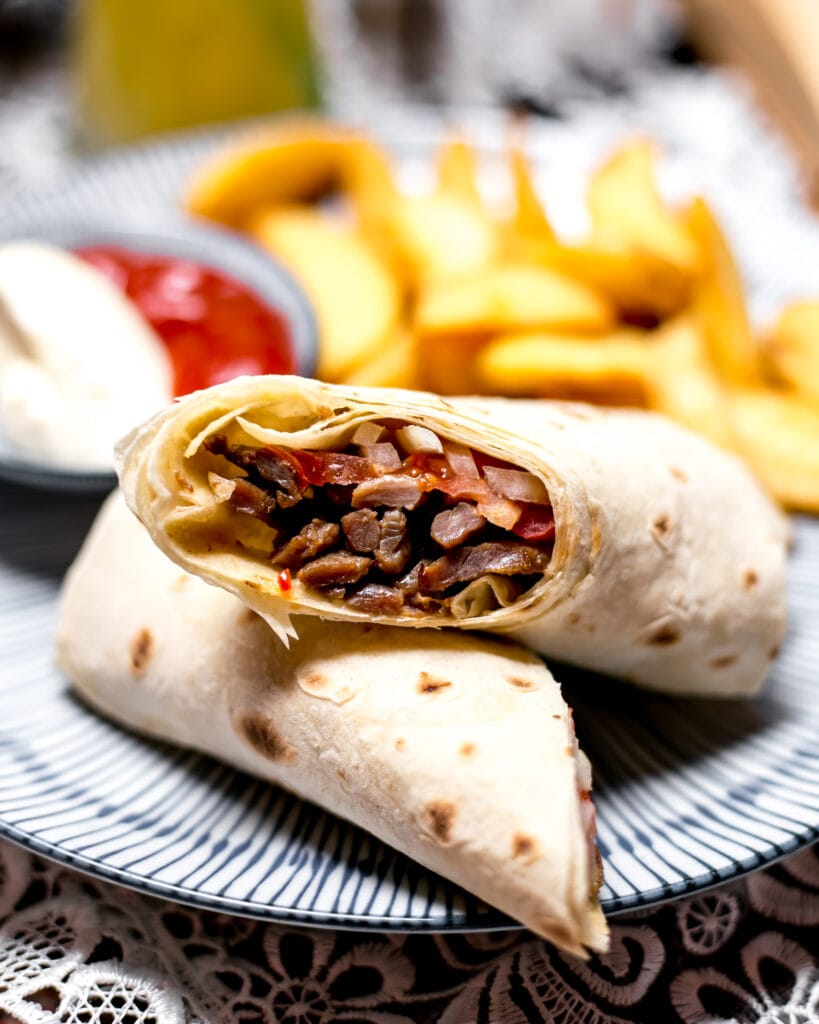Introduction
When it comes to breakfast staples, few dishes can truly rival the beloved breakfast burrito. Wrapped in a soft tortilla, it’s not only a portable powerhouse of flavor and energy but also a convenient way to combine protein, carbs, fats, and a spectrum of nutrients into a single package. However, for those mindful of their caloric intake or aiming to balance their diet more effectively, the question naturally arises: how many calories does a breakfast burrito actually pack? Ultimately, the answer hinges on the ingredients and portion sizes.
In this article, we’ll thoroughly explore the caloric content of breakfast burritos by analyzing their components, highlighting common variations, and providing practical tips for making healthier choices. By the end, you’ll not only have a detailed understanding of this iconic dish but also learn how to enjoy it without overloading on calories.
What is a Breakfast Burrito?
A breakfast burrito, at its core, is a tortilla filled with an assortment of breakfast favorites. The most common ingredients include:
- Scrambled eggs
- Cheese
- Potatoes (hash browns or home fries)
- Meat (bacon, sausage, or chorizo)
- Salsa or other condiments
Optional additions might include beans, avocado, sour cream, vegetables, or even rice. Each of these components contributes to the flavor, texture, and caloric content of the burrito.
Breaking Down the Calories
The caloric content of a breakfast burrito depends significantly on its ingredients, portion sizes, and preparation methods. Below is an estimate of the calorie contribution from common components in a standard breakfast burrito:
1. The Tortilla
The foundation of the breakfast burrito is the tortilla, often made from flour. A large flour tortilla (about 10 inches in diameter) typically contains:
- Calories: 300-350
- Carbohydrates: 50-60 grams
- Fat: 7-10 grams
Whole wheat or low-carb tortillas are lighter options, reducing the calorie count to around 200-250.
2. Scrambled Eggs
Eggs are a primary source of protein but also add fats and calories:
- 2 large eggs: 140 calories
- Fat: 10 grams
If cooked with butter or oil, an additional 50-100 calories may be added.
3. Cheese
Cheese contributes creaminess and flavor but is calorie-dense:
- 1/4 cup shredded cheddar cheese: 110 calories
- Fat: 9 grams
Opting for low-fat cheese can reduce this by about 40 calories.
4. Potatoes
Whether hash browns or home fries, potatoes add texture and heft:
- 1/2 cup cooked potatoes: 100-120 calories
- Fat: 4-6 grams (if fried, the fat content rises significantly)
5. Meat
Bacon, sausage, or chorizo are common protein choices, each with a unique caloric profile:
- 3 slices of bacon: 120 calories
- 2 sausage links: 180-200 calories
- 1/4 cup chorizo: 220 calories
Lean protein options like turkey sausage can cut this to around 100 calories.
6. Salsa and Condiments
Salsas are generally low-calorie, but sour cream and guacamole can quickly add up:
- 2 tablespoons salsa: 10 calories
- 2 tablespoons sour cream: 60 calories
- 2 tablespoons guacamole: 50 calories
7. Extras (Beans, Vegetables, Rice)
Adding vegetables like bell peppers or onions is a low-calorie way to enhance nutrition:
- 1/2 cup cooked beans: 120 calories
- 1/4 cup rice: 50 calories
- 1/4 cup sautéed vegetables: 30-40 calories
Calorie Range for Breakfast Burritos
Combining these elements, a breakfast burrito’s caloric range can vary widely:
- Basic Breakfast Burrito: 500-600 calories (eggs, cheese, salsa, and tortilla)
- Deluxe Breakfast Burrito: 700-900 calories (includes meat, potatoes, and sour cream)
- Loaded Breakfast Burrito: 1,000+ calories (with extras like guacamole, rice, and fried potatoes)
Some restaurant versions or oversized burritos can easily exceed 1,200 calories, especially when served with sides like chips or hash browns.
Learn more about Hidden Calories in Beef Dishes to understand how extras like fried meats can spike calorie counts.
Healthier Variations
If you’re aiming to enjoy a breakfast burrito without exceeding your calorie budget, here are some tips:
1. Choose a Smaller Tortilla
Opt for a smaller tortilla or a whole-wheat option to reduce calorie intake.
2. Focus on Lean Proteins
Replace bacon or sausage with turkey bacon, turkey sausage, or grilled chicken.
3. Go Light on Cheese
Use a smaller portion of cheese or switch to a lower-fat variety.
4. Load Up on Veggies
Add bell peppers, spinach, onions, and mushrooms for flavor and nutrients with minimal calories.
5. Use Cooking Sprays Instead of Oils
Minimize added fats by cooking eggs and potatoes with a nonstick spray instead of butter or oil.
6. Skip High-Calorie Extras
Limit sour cream and guacamole or use Greek yogurt as a creamy alternative.
For accurate nutritional information about each ingredient in your breakfast burrito, you can consult the USDA FoodData Central, a comprehensive database of food items and their caloric content. Additionally, if you want to ensure your breakfast burrito aligns with a balanced diet, refer to the Healthy Eating Plate from Harvard T.H. Chan School of Public Health for guidance on meal composition and portion sizes.
Restaurant Breakfast Burritos: Hidden Calories
When ordering a breakfast burrito at a restaurant, keep in mind the following calorie-inflating factors:
- Oversized Portions: Many restaurant burritos use large tortillas and generous fillings.
- Hidden Fats: Ingredients like fried potatoes, extra cheese, and creamy sauces are often included.
- Side Dishes: Hash browns or chips served on the side add additional calories.
Always check the nutritional information if available. Customizing your order to include more vegetables and fewer calorie-dense toppings can make a significant difference.
Homemade Breakfast Burritos
Making breakfast burritos at home allows you to control ingredients and portion sizes. Here’s a quick recipe for a healthier version:
Ingredients:
- 1 small whole-wheat tortilla (150 calories)
- 2 large eggs (140 calories)
- 1/4 cup low-fat cheddar cheese (80 calories)
- 1/4 cup sautéed spinach and bell peppers (30 calories)
- 2 tablespoons salsa (10 calories)
- 1 slice turkey bacon (35 calories)
Total Calories: ~445
Instructions:
- Cook the turkey bacon until crispy and set aside.
- Scramble the eggs with the sautéed vegetables.
- Warm the tortilla and layer with eggs, cheese, turkey bacon, and salsa.
Wrap tightly and enjoy!
How to Make a Healthier Breakfast Burrito
Choose Whole-Grain or Low-Calorie Tortillas
- Opt for smaller, whole-wheat tortillas with fewer calories and more fiber.
Go Heavy on Vegetables
- Fill your burrito with nutrient-dense, low-calorie veggies like spinach, peppers, onions, and tomatoes.
Lean Protein Choices
- Swap high-fat meats like sausage or bacon for leaner options like turkey bacon, grilled chicken, or plant-based proteins.
Limit High-Calorie Extras
- Use small amounts of cheese, sour cream, and guacamole, or try lower-fat alternatives.
Skip or Reduce Potatoes
- If you’re looking to cut carbs, skip the potatoes altogether or replace them with sweet potatoes for a nutrient-rich option.
Cook Smart
- Use non-stick pans or cooking sprays instead of butter or oil to save hundreds of calories.
Popular Breakfast Burrito Variations
Different regions and culinary styles put unique spins on the breakfast burrito, and each comes with its own calorie profile.

Tex-Mex Breakfast Burrito
- Features spicy chorizo, refried beans, and jalapeños.
- Calories: 800–1,200.
California Breakfast Burrito
- Includes carne asada and French fries inside the tortilla.
- Calories: 1,000–1,500.
Vegetarian Breakfast Burrito
- Packed with eggs, cheese, black beans, and vegetables.
- Calories: 400–700.
Vegan Breakfast Burrito
- Uses tofu scramble, black beans, avocado, and a vegan tortilla.
- Calories: 300–600.
Final Thoughts: How Many Calories Are Too Many?
The “right” number of calories in a breakfast burrito depends on your dietary goals and activity level. A 400–600 calorie burrito is reasonable for most people, providing a balanced mix of macronutrients. If you’re indulging in a larger or more calorie-dense burrito, consider splitting it into two meals.
Breakfast burritos are versatile and delicious, but they can easily become calorie bombs. Understanding their nutritional components allows you to make informed choices, ensuring you enjoy this hearty dish without compromising your health goals.
FAQs
1. How many calories are in a breakfast burrito?
The calorie count of a typical breakfast burrito can vary depending on its ingredients and size, but on average, a standard breakfast burrito contains 300 to 500 calories. The calories come from ingredients like eggs, cheese, tortillas, bacon, sausage, or potatoes. The type of filling (e.g., adding guacamole or extra cheese) can also increase the calorie count.
2. How many calories in a Good Times breakfast burrito?
Good Times Breakfast Burritos can range in calories depending on the specific item you choose. A typical Good Times breakfast burrito contains around 600 to 800 calories. This can vary depending on the fillings (such as bacon, sausage, or potatoes) and the size of the burrito.
3. Why is a breakfast burrito healthy?
A breakfast burrito can be healthy when made with nutritious ingredients like whole-grain tortillas, lean proteins (such as eggs, turkey, or beans), vegetables (like spinach, peppers, and onions), and healthy fats (such as avocado). It provides a good mix of protein, fiber, and essential vitamins and minerals, making it a balanced and filling option that can keep you energized throughout the morning. However, it’s important to watch portion sizes and avoid excessive amounts of cheese, sour cream, or fatty meats, which can make it less healthy.
4. Can I eat a breakfast burrito on a diet?
Yes, you can eat a breakfast burrito on a diet, but it’s important to make mindful choices. To keep it healthier and lower in calories, you can:
- Choose a whole wheat or low-calorie tortilla.
- Opt for lean protein sources like scrambled eggs, turkey bacon, or beans instead of fatty meats like sausage or chorizo.
- Add more vegetables to increase fiber and nutrients without adding many calories.
- Skip or limit high-calorie toppings like cheese, sour cream, and guacamole. By making these adjustments, you can enjoy a filling, nutritious breakfast burrito while staying within your dietary goals.
Conclusion
A breakfast burrito can be as indulgent or as health-conscious as you choose to make it. By understanding its components and making mindful substitutions, you can savor this morning classic without exceeding your caloric needs. Whether you’re grabbing one on the go or crafting it at home, the power is in your hands to strike the perfect balance between flavor and nutrition.
If you’re interested in creating balanced, calorie-conscious meals, explore our Complete Guide to Cooking for inspiration.

